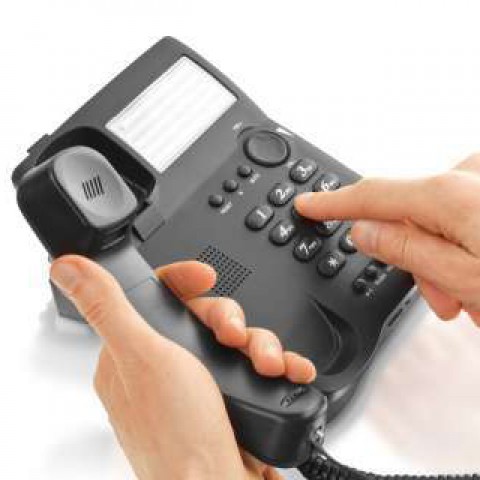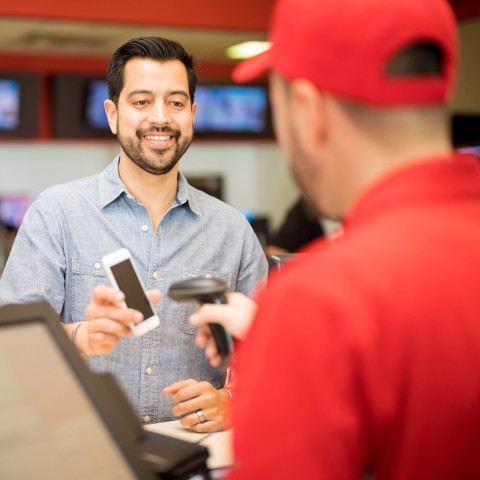
Knowing how to communicate over the phone is an essential skill.
Whether you want to make a reservation at a restaurant or discuss business plans with your long-distance colleague, you’ll need to pick up the phone!
Holding a phone conversation is difficult enough in one’s native language, let alone in a foreign language like Korean! But don’t worry.
In this article, you’ll learn some essential Korean phone conversation phrases and see dialogue examples showing how they might be used. By the time you’ve finished reading, you’ll be able to confidently make a phone call in Korean for any situation!
 Table of Contents
Table of Contents
- Picking up the Phone
- Saying Who You Are
- Stating the Reason for Your Call
- Asking to Speak to Someone
- Asking Someone to Wait
- Leaving a Message
- Asking for Clarification
- Sample Phone Conversations
- How KoreanClass101 Can Help You Master the Korean Language
1. Picking up the Phone
There are a number of different ways to answer the phone in Korean. The standard phrase is 여보세요 (yeoboseyo), though if you’re in a business setting or calling customer service, they’ll answer the phone differently.
Below, you’ll find a few different phrases that are used to answer a phone call in Korean.
1) 여보세요 (yeoboseyo)
You’ve likely heard this phrase many times already if you watch Korean dramas!
여보세요 (yeoboseyo), meaning “hello” in English, is the standard Korean phone greeting and is only used over the phone. Keep in mind that there are no “polite” or “casual” ways to answer the phone in Korean; we use this set phrase by default, unless we’re answering the phone in a business context (more on this later).
The phrase 여보세요 (yeoboseyo) is a combination of several words:
- 여기 (yeogi) – “here”
- 보다 (boda) – “to see”
- 세요 (seyo) – “~do”
Additional Notes: Another common way to answer the phone is with the elongated sound 네 (ne), meaning “yes.” This greeting is commonly used by elders in Korea.
Example:
A:
여보세요.
(Yeoboseyo.)
“Hello.”
B:
여보세요, 누구세요?
(Yeoboseyo, nuguseyo?)
“Hello, who is this?”
2) 무엇을 도와드릴까요? (Mueoseul dowadeurilkkayo?)
This phrase means “How may I help you?” in English. It’s commonly used by customer service representatives to start a conversation with the caller. They usually state the name of the company, followed by their name, before saying this phrase.
Example:
A 회사의 김미영입니다. 무엇을 도와드릴까요?
(A hoesaui gimmiyeongimnida. Mueoseul dowadeurilkkayo?)
“This is A company’s Kim Mi-yeong speaking. How may I help you?”
3) 뭐 해? (Mwo hae?)
This is a more casual greeting used both on the phone and in 카카오톡 (kakaotok), or “Kakaotalk.” Kakaotalk, commonly referred to as 카톡 (katok) or “KaTalk” in South Korea, is a free mobile instant messaging application (similar to Line, WeChat, etc.). The majority of Koreans use Kakaotalk to send messages and call each other.
There is a casual form and a more polite form of this phrase, both meaning “What are you up to?”
- Casual: 뭐 해? (Mwo hae?)
- Polite: 지금 뭐 하세요? (Jigeum mwo haseyo?)
Both versions are commonly used to initiate conversation, but you need to make sure that you and the other person have established rapport before using either one. If you say this to a stranger or someone you don’t know well, you may sound rude or the receiver may misinterpret your intentions.
- → Check out our lesson Calling on Skype to learn more about saying hello over the phone.

2. Saying Who You Are
It’s important to say who you are before jumping into the topic you want to talk about. There are different Korean phone phrases you can use to introduce yourself, so let’s have a look at each one.
1) [회사이름] 의 [이름]입니다. ([Hoesaileum] ui [ireum]imnida.)
This phrase translates to: “This is [name] of the [company’s name].”
It’s a formal way to introduce yourself over the phone and it’s commonly used in business settings.
While 여보세요 (yeoboseyo) is the standard phone call greeting in Korea, you should avoid using it in business settings or other formal contexts as it sounds less professional.
When a receptionist answers the phone, for example, they usually say [회사이름] 의 [이름]입니다. You can reply using the same phrase pattern in order to let them know who you are.
Example:
A:
코리안클래스101의 폴입니다.
(Koreankeullaseu101ui porimnida.)
“This is Paul from KoreanClass101.”
B:
안녕하세요, A사의 앨리스입니다.
(Annyeonghaseyo, A-saui aelliseuimnida.)
“Hello, this is Alice from A company.”
2) 안녕하세요, [이름]입니다. (Annyeonghaseyo, [ireum]imnida.)
Another common way to introduce yourself in business settings is:
- 안녕하세요, [이름]입니다. (Annyeonghaseyo, [ireum]imnida.) – “Hello, this is [name].”
You may also hear this phrase preceded by the sound 네 (ne):
- 네, 안녕하세요, [이름] 입니다. (Ne, annyeonghaseyo, [ireum]imnida.)
Which phrase is more polite? There’s no right or wrong answer, so choose the version that feels right to you.
Example:
A:
네, B사의 진입니다.
(Ne, B-saui jinimnida.)
“Hello, this is Jin from B company.”
B:
안녕하세요 진씨. 저는 C사의 연아라고합니다.
(Annyeonghaseyo jinssi. Jeoneun C-saui yeonaragohamnida.)
“Hello Jin. This is Yeona from C company.”
3) 안녕하세요, [회사이름] 의 [이름] 입니다. (Annyeonghaseyo, [hoesaileum]ui [ireum] imnida.)
This phone introduction phrase translates to: “Hello. This is [name] of the [company’s name].” It is the most polite and common way to introduce oneself over the phone in business settings.
Do you see the pattern?
In business settings, you need to greet, state your company, and give your name.
Once you know this pattern and get some practice using it, you’ll have no problem introducing yourself in formal contexts!
Example:
A사의 김미영입니다.
(A-saui gimmiyeongimnida.)
“This is Kim Miyeong of A company.”
- → Want to learn more useful business phrases? Then check out our lesson Korean Greetings at Business Establishments.
4) 나야 (naya)
The Korean phrase 나야 (naya), meaning “It’s me,” is commonly used among friends. Feel free to use it when the call receiver knows you well, instead of telling him or her who you are.
There are two other versions of this phrase you could also use:
- 어 나야 (eo naya) – “Hey, it’s me.”
- 나 소연 (na soyeon) – “I’m Soyeon.”
Example:
A: 여보세요? (Yeoboseyo?) – “Hello?”
B: 어 나야. (Eo naya.) – “Hey, it’s me.”
A: 어 안녕. (Eo annyeong.) – “Oh hey, hello.”
B: 뭐 해? (Mwo hae?) – “What are you up to?”
A: 아무것도 안해. (Amugeotdo anhae.) – “Nothing.”
5) 나 [이름] (na [ireum])
This phrase means “It’s [name],” and it’s frequently used among friends.
Example:
A: 여보세요. (Yeoboseyo?) – “Hello?”
B: 나 소연. (Na soyeon.) – “It’s Soyeon.”
- → Make sure to visit our lesson Useful Phrases for a Phone Call to learn more useful Korean phrases!

3. Stating the Reason for Your Call
A vital step in your Korean phone call conversation is to let the receiver know why you’re calling. Effective communication is key here!
1) 예약하려고 전화드렸어요. (Yeyaghalyeogo jeonhwadeuryeosseoyo.)
If you plan to meet a friend for lunch or have a dinner date coming up, you’ll need to know this phrase! It means: “I am calling to make a reservation.”
In order to reserve a table for lunch or dinner specifically, you would add the appropriate word to the beginning of the phrase.
For example, to say “I want to make a reservation for lunch,” add the Korean word for “lunch” to the beginning of this phrase:
A:
안녕하세요, A 레스토랑입니다.
(Annyeonghaseyo, A reseutorangimnida.)
“Hello, this is A restaurant.”
B:
안녕하세요, 점심 예약하려고 전화드렸어요.
(Annyeonghaseyo, jeomsim yeyakaryeogo jeonhwadeuryeosseoyo.)
“Hello, I am calling to make a reservation for lunch.”
A:
네, 몇분이시죠?
(Ne, myeotbunisijyo?)
“Okay, how many people?”
2) 문의 드릴것이 있어서 전화드렸어요. (Munui deurilgeosi isseoseo jeonhwadeuryeosseoyo.)
Translation: “I am calling because I have an inquiry.”
You can use this phrase if the purpose of your call is to receive an answer to a question or to gain more information about something.
If you want to make it even more polite or business-like, you could say:
- 문의드릴것이 있어서 전화드렸습니다. (Mun-uideulilgeos-i iss-eoseo jeonhwadeulyeossseubnida.)
If you want to say it casually (to a friend, for example), you could say:
- 물어볼것이 있어서 전화했어. (Mul-eobolgeos-i iss-eoseo jeonhwahaess-eo.)
Example:
A:
콜센터 린입니다. 무엇을 도와드릴까요?
(Kolsenteo linimnida. Mueoseul dowadeurilkkayo?)
“This is Lyn from the call center. How may I help you?”
B:
안녕하세요, 문의드릴것이 있어서 전화드렸어요.
(Annyeonghaseyo, munui deurilgeosi isseoseo jeonhwadeuryeosseoyo.)
“Hello, I am calling because I have an inquiry.”
4) 뭐하고 있는지 궁금해서 전화해봤어. (Mwohago inneunji gunggeumhaeseo jeonhwahaebwasseo.)
This one means: “I called because I am curious what you are doing now.”
You could say this phrase to a friend or to someone you want to get to know better.
Example:
A:
여보세요.
(Yeoboseyo.)
“Hello.”
B:
어, 나야.
(Eo, naya.)
“Hey, it’s me.”
A:
어, 무슨일 있어?
(Eo, museunil isseo?)
“Uh, what’s up?”
B:
뭐하고 있는지 궁금해서 전화해봤어.
(Mwohago inneunji gunggeumhaeseo jeonhwahaebwasseo.)
“I called because I am curious what you are doing now.”
5) 안 본지 너무 오래돼서 잘 지내는지 궁금해서 전화해봤어. (An bonji neomu oraedwaeseo jal jinaeneunji gunggeumhaeseo jeonhwahaebwasseo.)
This is a casual way to say: “It’s been awhile since we saw each other, so I called to check up on you.”
Example:
A:
여보세요.
(Yeoboseyo.)
“Hello.”
B:
어, 나야.
(Eo, naya.)
“Hey, it’s me.”
A:
안본지 너무 오래돼서 잘지내는지 궁금해서 전화해봤어.
(An bonji neomu oraedwaeseo jal jinaeneunji gunggeumhaeseo jeonhwahaebwasseo.)
“It’s been awhile since we saw each other, so I called to check up on you.”
6) 전화했었어? (Jeonhwahaesseosseo?)
This is another common Korean phone call phrase, often used to start a conversation. It means: “Did you call?”
Example:
A: 여보세요. (Yeoboseyo.) – “Hello.”
B: 어, 나 소연. 전화했었어? (Eo, na soyeon. Jeonhwahaesseosseo?) – “Hey, it’s Soyeon. Did you call?”
A: 아 어, 했었어. (A eo, haesseosseo.) – “Ah, yeah I did.”
- → Free vocabulary list for you! Screen Time: Words and Phrases for Using Your Smartphone.

4. Asking to Speak to Someone
If you’re calling a home phone or business line (or if someone else answers your friend’s smartphone!), you might need to ask to speak to another individual. Here are some Korean phrases you can use to do this.
1) [이름] 집에 있습니까? ([Ileum] jibe issseumnikka?)
If you’re trying to reach a friend and someone else picks up the phone, you can use this phrase to ask if they can put your friend on the line. This phrase means: “Is [name] home?”
Example:
A: 여보세요. (Yeoboseyo.) – “Hello.”
B: 어, 나 소연. (Eo, na soyeon.) – “Hey, it’s Soyeon.”
A: 에이미 집에 있습니까? (Eimi jibe issseumnikka?) – “Is Amy home?”
2) ___씨와 통화할 수 있을까요? (___ssiwa tonghwahal su isseulkkayo?)
This phrase translates to: “Could I speak to ___, please?”
In business settings, it’s good etiquette to use either 씨 (ssi) or 님 (nim) when asking to speak to someone. Both mean “Mr. / Mrs. / Ms.” but 님 (nim) is considered more polite than 씨 (ssi). If you’re not sure which word to use, pay close attention to your colleagues. Which one do they use? If you notice that they use one instead of the other, then follow their lead.
Example:
A:
코리안클래스101의 폴입니다.
(Koreankeullaeseu101ui porimnida.)
“This is Paul from KoreanClass101.”
B:
안녕하세요, A사의 김미영입니다. 앨리스 씨와 통화할 수 있을까요?
(Annyeonghaseyo, A-saui gimmiyeongimnida. Aelliseu ssiwa tonghwahal su isseulkkayo?)
“Hello, this is Kim Miyeong of A company. Could I speak to Alice, please?”
A:
연결해드리겠습니다.
(Yeongyeolhaedeurigetseumnida.)
“I will put you through.”
3) [Family name] [Job title]님 + 자리에 계신가요? ([Family name] [Job title]nim + jarie gyesingayo?)
This phrase means: “Is Mr./Ms. [Name] there?”
It’s a common way to ask if someone is available to speak.
Example:
A:
코리안클래스101의 폴입니다.
(Koreankeullaeseu101ui porimnida.)
“This is Paul from KoreanClass101.”
B:
안녕하세요, A회사의 김미영입니다. 앨리스님 자리에 계신가요?
(Annyeonghaseyo, A-saui gimmiyeongimnida. Alliseunim jarie gyesingayo?)
“Hello, this is Kim Miyeong of A company. Is Alice there?”
A:
네, 자리에 계십니다. 지금 바로 연결해드리겠습니다.
(Ne, jarie gyesimndal. Jigeum baro yeongyeolhaedeurigetseumnida.)
“Yes, she is here. I will put you through.”
4) [이름] 지금 집에 있어? ([Ireum] jigeum jibe isseo?)
This is a casual way to ask “Is [name] at home?”
Example:
A:
여보세요.
(Yeoboseyo.)
“Hello.”
B:
나 연아인데, 가연이 지금 집에 있어?
(Na yeonainde, gayeoni jigeum jibe isseo?)
“I’m Yeona, is Gayeon at home?”
5) [이름] 바꿔줄래? ([Ireum] bakkwojullae?)
This is a casual way to ask “Can you put me through to [name?]” If you want to say it politely, use:
- [이름] 바꿔주시겠습니까? (Iireum] bakkwojusigetseumnikka?) – “Can you please put me through to [name]?”
Example:
A: 여보세요. (Yeoboseyo.) – “Hello.”
B: 가연이 바꿔줄래? (Gayeoni bakkwojullae?) – “Can you put me through to Gayeon?”
6) [이름] 이랑 통화할 수 있을까? ([Ireum] irang tonghwahal su isseulkka?)
This is a casual way to ask “Can I speak to [name]?” in Korean. A more polite version is:
- [이름]씨와 통화할 수 있을까요? ([Ireum] ssiwa tonghwahal su isseulkkayo?) – “Can I please speak to [name]?”
Example:
A: 여보세요. (Yeoboseyo.) – “Hello.”
B: 가연이랑 통화할 수 있을까? (Gayeonirang tonghwahal su isseulkka?) – “Can I speak to Gayeon?”
- → Do you want to boost your confidence in speaking business Korean? Then check out our lesson series Business Korean for Beginners to really learn the ropes!

5. Asking Someone to Wait
Especially in business settings, it’s common practice to ask the other person to wait while you connect them or retrieve requested information. Here are a few ways you can do this in Korean:
1) 잠시만요. (Jamsimanyo.)
This Korean phone call phrase translates to: “Hold on, please.”
Example:
A: 앨리스님 자리에 계신가요? (Aelliseunim jarie gyesingayo?) – “Could I speak to Alice, please?”
B: 그럼요. 잠시만요. (Geureomyo. Jamsimanyo.) – “Of course. Hold on, please.”
2) 잠시만 기다려주세요. (Jamsiman gidaryeojuseyo.)
This phrase has the same meaning as the one above, but it’s considered more polite.
Example:
A: 앨리스님 자리에 계신가요? (Aelliseunim jarie gyesingayo?) – “Could I speak to Alice, please?”
B: 잠시만 기다려주세요. (Jamsiman gidaryeojuseyo.) – “Hold on, please.”
3) [이름] 씨 연결해 드리겠습니다. ([Ileum] ssi yeongyeolhae deurigetseumnida.)
This phrase means: “I’ll put you through to [name].”
If you ask to speak to someone, the person on the other end of the call may say this phrase to let you know you’re being transferred. You might also hear this phrase used without the name:
- 연결해 드리겠습니다. (Yeongyeolhae deurigetseumnida.)
Example:
A: 연아 씨 지금 자리에 계신가요? (Yeona ssii jigeum jarie gyesingayo?) – “Could I speak to Yeona, please?”
B: 네, 연결해 드리겠습니다. (Ne, yeongyeolhae deurigetseumnida.) – “Yes, I will put you through.”
4) 죄송하지만 ___씨가 잠시 자리를 비웠습니다. (Joesonghajiman ___ssiga jamsi jalireul biwotseumnida.)
This phrase means: “I’m afraid ___ isn’t in at the moment.”
죄송 (jeosong) means “sorry” and 하지만 (hajiman) means “but.” Together, it means: “I am sorry, but…”
Example:
A:
연아씨 지금 자리에 계신가요?
(Yeona ssii jigeum jarie gyesingayo?)
“Could I speak to Yeona, please?”
B:
죄송하지만 연아씨가 잠시 자리를 비웠습니다.
(Joesonghajiman yeona ssiga jamsi jalireul biwotseumnida.)
“I am afraid Yeona isn’t in at the moment.”
5) 메시지를 남기시겠어요? (Mesijireul namgisigesseoyo?)
If the person you wish to speak to is not available, you may be able to leave a message. The receptionist may ask you: 메시지를 남기시겠어요? (Mesijireul namgisigesseoyo?) – “Would you like to leave a message?”
Broken down, 메시지 (meseji) means “message” and 남기다 (namgida) means “to leave.”
You might also be asked:
- 성함이랑 전화번호 알려주시겠어요? (Seonghamirang jeonhwabeonho allyeojusigesseoyo?) – “Could you tell me your name and phone number?”
Example:
A:
연아씨 지금 자리에 계신가요?
(Yeona ssii jigeum jarie gyesingayo?)
“Could I speak to Yeona, please?”
B:
죄송하지만 연아 씨가 잠시 자리를 비웠습니다. 메시지를 남기시겠어요?
(Joesonghajiman yeona ssiga jamsi jarireul biweotseumnida. Mesijireul namgisigesseoyo?)
“I am afraid Yeona isn’t in at the moment. Would you like to leave a message?”
6) 통화중입니다. (Tonghwajungimnida.)
This phrase translates to: “He/she is on the phone right now.”
It’s one of many possible reasons the call receiver might give you for the other party not being available. Here are more reasons you might hear:
- 미팅중입니다. (Mitingjungimnida.) – “He/she is in a meeting.”
- 점심식사중입니다. (Jeomsimsiksajungimnida.) – “He/she is having lunch.”
- 지금 자리에 안 계십니다. (Jigeum jarie an gyesimnida.) – “He/she is not in his/her seat right now.”
- 외부 미팅중입니다. (Oebu mitingjungimnida.) “He/she is out on a meeting.”
Example:
A: 연아씨 지금 자리에 계신가요? (Yeona ssii jigeum jarie gyesingayo?) – “Could I speak to Yeona, please?”
B: 연아씨 지금 통화중입니다. (Yeona ssii jigeum tonghwajungimnida) – “Yeona is on the phone right now.”
7) 잠깐만. (Jamkkanman.) / 잠만. (Jamman.)
잠만 (jamman) is a shortened version of 잠깐만 (jamkkanman), and it’s considered a slang term. Both versions mean “hold on,” and they’re best used among friends rather than in business settings.
Example:
A:
나 집에 열쇠 두고 간 것 같은데 한번 봐줄래?
(Na jibe yeolsoe dugo gan geot gateunde hanbeon bwajullae?)
“I think I left my keys at home. Can you have a look at it for me?”
B:
잠깐만.
(Jamkkanman.)
“Hold on.”
8) 지금 전화 못 받는데. (Jigeum jeonhwa mot batneunde.)
This is a casual phrase often used among friends. It means: “I can’t talk on the phone right now.”
Example:
A:
여보세요, 지금 전화가능?
(Yeoboseyo, jigeum jeonhwaganeung?)
“Hello, are you available for a call?”
B:
미안, 지금 샤워중이라 전화 못 받는데.
(Mian, jigeum syawojungira jeonhwa mot batneunde.)
“I am sorry, I’m taking a shower so I can’t talk right now.”
- → Learn how to ask about other people and how they’ve been in our lesson Calling on Skype II (How Ya Been?).

6. Leaving a Message
If you’ve made an urgent phone call only to find out the person you need to speak to is unavailable, you can ask to leave a message. Here are three Korean phone phrases you could use:
1) 전화했었다고 전해주실래요? (Jeonhwahaesseotdago jeonhaejusillaeyo?)
Translation: “Could you please tell him/her that I called?”
Example:
A:
죄송하지만 연아씨가 잠시 자리를 비웠습니다. 메시지를 남기시겠어요?
(Joesonghajiman yeona ssiga jamsi jarireul biweotseumnida. Mesijireul namgisigesseoyo?)
“I am afraid Yeona isn’t in at the moment. Would you like to leave a message?”
B:
알겠습니다. 그럼 전화했었다고 전해주실래요?
(Algetseumnida. Geureom keonhwahaesseotdago jeonhaejusillaeyo?)
“Okay. Could you please tell him/her that I called?”
2) 나중에 다시 전화하겠습니다. (Najunge dasi jeonhwahagetseumnida.)
Translation: “I’ll call again later.”
Example:
A:
죄송하지만 연아씨가 잠시 자리를 비웠습니다. 메시지를 남기시겠어요?
(Joesonghajiman yeona ssiga jamsi jarireul biweotseumnida. Mesijireul namgisigesseoyo?)
“I am afraid Yeona isn’t in at the moment. Would you like to leave a message?”
B:
괜찮습니다. 나중에 다시 전화하겠습니다.
(Gwaenchanseumnida. Najunge dasi jeonhwahagetseumnida.)
“Fine. I’ll call again later.”
3) 메시지 남겨주시겠습니까? (Mesijireul namgyeojusigetseumnikka?)
Translation: “Could you leave a message?”
Example:
A: 메시지 남겨주시겠습니까? (Mesijireul namgyeojusigetseumnikka?) – “Could you leave a message?”
B: 전화번호가 어떻게 되시죠? (Jeonhwabeonhoga eotteoke doesijyo?) – “What’s your number?”

7. Asking for Clarification
As a non-native speaker making a phone call in the Korean language, you might have difficulty understanding what the other person is saying. This problem could become exacerbated if there’s bad reception in your area. Here are a few phrases you could use to ask for clarification when needed:
1) 좀 더 크게 말씀해 주시겠어요? (Jom deo keuge malsseumhae jusigesseoyo?)
This phrase translates to: “Could you speak up a bit more, please?”
Let’s break it down:
- 좀 더 (jom deo) – “a bit more”
- 크게 (keuge) – “louder”
- 말씀해 주시겠어요 (malsseumhaejusigesseoyo) – “speak please”
This is a polite/business way to ask someone to speak louder.
Examples:
진호 씨, 죄송하지만 좀 더 크게 말씀해 주시겠어요?
(Jinho ssi, joesonghajiman jom deo keuge malsseumhae jusigesseoyo?)
“Mr. Jinho, I am sorry but could you speak up a bit more, please?”
리나 씨, 목소리가 잘 안 들려요. 좀 더 크게 말씀해 주시겠어요?
(Rina ssi, moksoriga jal an deullyeoyo. Jom deo keuge malsseumhae jusigesseoyo?)
“Ms. Rina, I can barely hear you. Could you speak up a bit more, please?”
2) 다시 말씀해 주시겠어요? (Dasi malsseumhae jusigesseoyo?)
This one means: “Could you repeat that, please?” A common variation is:
- 다시한번만 말씀해주시겠어요? (Dasihanbeonman malsseumhaejusigess-eoyo?) – “Could you say that again, please?”
Example:
목소리가 잘 안들렸어요. 다시 말씀해 주시겠어요?
(Moksoriga jal andeullyeosseoyo. Dasi malsseum hae jusigesseoyo?)
“I could not hear you. Could you repeat that, please?”
3) 잘 안들리는데 다시 말씀해 주시겠어요? (Jal andeullineunde dasi malsseumhae jusigesseoyo?)
This one translates to: “I’m having a hard time hearing you, can you say that again please?”
We use this phrase to let the person know that we cannot hear his or her voice, and that we’d like them to repeat what they just said.
Example:
죄송해요. 잘 안들리는데 다시 말씀해 주시겠어요?
(Joesonghaeyo. Jal andeullineunde dasi malsseumhae jusigesseoyo?)
“Sorry, I’m having a hard time hearing you, can you say that again please?”
4) 전화 상태가 너무 안좋은데요. (Jeonhwa sangtaega neomu anjoeundeyo.)
If you’re struggling to hear due to a bad connection, you can use this phrase to let the other person know. The phrase means: “The connection is not good.”
Breaking it down:
- 전화 상태 (jeonhwa sangtae) – “connection”
- 너무 (neomu) – “too”
- 안 좋은데요 (an joeundeyo) – “is not good”
Examples:
여보세요, 전화 상태가 너무 안좋은데요. 다시 걸어보겠습니다.
(Yeoboseyo, jeonhwa sangtaega neomu anjoeundeyo. Dasi georeobogetseumnida.)
“Hello, the connection is not good. I will try to call you again.”
전화상태가 너무 안좋은데요. 제 목소리 들리시나요?
(Jeonhwa sangtaega neomu anjoeundeyo. Je moksori deullisinayo?)
“The connection is not good. Can you hear my voice?”
여보세요? 전화상태가 너무 안좋은데요. 여보세요?
(Yeoboseyo? Jeonhwa sangtaega neomu anjoeundeyo. Yeoboseyo?)
“Hello? The connection is not good. Hello?”
5) 들리시나요? (Deullisinayo?)
This phrase means: “Can you hear me?”
You could say this phrase if you can barely hear the other person over the phone. Alternatively, you could repeat “hello” twice to indicate that the connection is not stable:
- 여보세요? 여보세요? (Yeoboseyo? Yeoboseyo?)
Another option is the phrase:
- 제 목소리 들리시나요? (Je mogsoli deullisinayo?) – “Can you hear my voice?”
Example:
A:
여보세요? 여보세요?
(Yeoboseyo? Yeoboseyo?)
“Hello? Hello?”
B:
네, 여보세요. 제 목소리 들리시나요?
(Ne, yeoboseyo. Je moksori deullisinayo?)
“Yes, hello. Can you hear my voice?”
A:
아 네, 이제 들려요.
(A ne, ije deullyeoyo.)
“Yes, I can hear you now.”
6) 뭐라고? (Mworago?)
This phrase means “What?” and it’s used among friends.
Example:
- 여보세요? 뭐라고? (Yeoboseyo? Mworago?) – “Hello? What?”
7) 잘 안들려. (Jal andeullyeo.)
This phrase means “I can’t hear you,” and it’s used among friends. If you want to say it more politely, it would be:
- 잘 안들려요. (Jal andeullyeo.) / 잘 안들립니다. (Jal andeullimnida.)
Examples:
여보세요? 야 잘 안들려. (Yeoboseyo? Ya, jal andeullyeo.) – “Hello? I can’t hear you.”
뭐라고? 잘안들려. (Mworago? Jal andeullyeo.) – “What did you say? I can’t hear you.”
8) 다시 한번 말해줄래? (Dasi hanbeon malhaejullae?)
This phrase means “Can you say it again?” and it’s used among friends only.
Examples:
미안, 다시한번 말해줄래?
Mian, dasi hanbeon malhaejullae?
“Sorry, can you say that again?”
미안, 다시 한번만 말해줄래?
Mian, dasi hanbeonman malhaejullae?
“Sorry, can you say that again?”
잘 안들렸어. 다시한번 말해줄래?
Jal andeullyeosseo. Dasi hanbeon malhaejullae?
“I couldn’t hear you. Can you say that again?”
- →Do you want to know Korea’s country code and other interesting information about Korean telephone numbers? Check out this Wikipedia page on telephone numbers in South Korea.

8. Sample Phone Conversations
Now that we’ve gone through different Korean phone call phrases, let’s have a look at a couple of sample conversations. One scenario uses only informal language and the other uses formal language.
1) Informal Phone Conversation
Scenario: Two friends (Yeongung and Hyunna) are setting up a time to meet for brunch on a weekend.
영웅:
여보세요.
(Yeoboseyo.)
“Hello.”
현아:
어. 영웅. 전화했었어?
(Eo, Yeongung. Jeonhwahaesseoseo?)
“Hey Yeongung. Did you call?”
영웅:
응. 안본지 오래됐는데 같이 점심이라도 먹을까?
(Eung. Anbonji oraedwaetneunde gachi jeomsimirado meogeulkka?)
“It’s been awhile since we’ve met. Do you want to have lunch with me?”
현아:
응 좋아. 어디로 갈까?
(Eung joa. Eodiro galkka?)
“Yes, sounds good. Where should we go?”
영웅:
괜찮은곳 알아. 이번 주 금요일 한 시 어때?
(Gwaenchaneungot ara. IIbeon ju geumyoil han si eottae?)
“I know a good place. How about Friday at one o’clock?”
현아:
응 좋아.
(Eung joa.)
“Yeah, sounds good.”
영웅:
알았어. 그럼 예약 잡고 장소 카톡으로 보낼께.
(Arasseo. Geureom yeyak japgo jangso katogeuro bonaelkke.)
“Okay. I will make a reservation and send a message to you on Kakaotalk.”
현아:
어어 알았어. 고마워!
(Eoeo arasseo. Gomawo!)
“Okay. Thanks!”
2) Formal Phone Conversation
Scenario: After they’ve set the time and place, Yeongung calls the restaurant to reserve a table.
웨이터:
A 레스토랑입니다.
(A reseutorangimnida.)
“This is A restaurant.”
영웅:
여보세요, 점심 예약하려고 전화드렸어요.
(Yeoboseyo, jeomsim yeyakaryeogo jeonhwadeuryeosseoyo.)
“Hello, I am calling to make a reservation for lunch.”
웨이터:
네, 언제로 잡아드릴까요?
(Ne, eonjero jabadeurilkkayo?)
“Okay. When would you like to come?”
영웅:
이번 주 금요일 한 시요.
(Ibeon ju geumyoil han siyo.)
“This Friday at one p.m., please.”
웨이터:
몇 분이세요?
(Myeot buniseyo?)
“How many people?”
영웅:
두 명입니다.
(Du myeongimnida.)
“Two people.”
웨이터:
성함은 어떻게 되세요?
(Seonghameun eotteoke doeseyo?)
“Can I have your name, please?”
영웅:
김영웅입니다.
(Gimyeongungimnida.)
“It’s Kim Yeongung.”
웨이터:
네 알겠습니다. 이번주 금요일 한 시 김영웅 씨 이름으로 테이블 예약해드리겠습니다.
(Ne algetseumnida. Ibeonju geumyoil han si gimyeongung ssi ireumeuro teibeul yeyakaedeurigetseumnida.)
“Okay. I reserved a table for this Friday at one p.m. under the name of Kim Yeongung.”
영웅:
네 알겠습니다. 감사합니다.
(Ne algetseumnida. Gamsahamnida.)
“Okay. Thank you.”
웨이터:
그때 봐.
(Geuttae bwa.)
“See you then.”
- → Make sure to check out our blog post Korean Etiquette: 7 Do’s and Don’ts in Korea for more information on how to manage different situations in South Korea!

9. How KoreanClass101 Can Help You Master the Korean Language
Once you memorize these useful Korean phone call phrases and learn how to use them, you’ll be able to confidently speak on the phone in both formal and informal settings.
Want to learn more about Korean culture and business etiquette? Or maybe you’d like to study even more practical everyday Korean phrases? Then you should definitely check out KoreanClass101! We provide a range of free learning resources, including vocabulary lists and audio/video lessons. It’s our goal to make learning Korean fun and to infuse each lesson with useful information on Korean culture.
Create your free lifetime account today and advance your Korean language skills with us!










